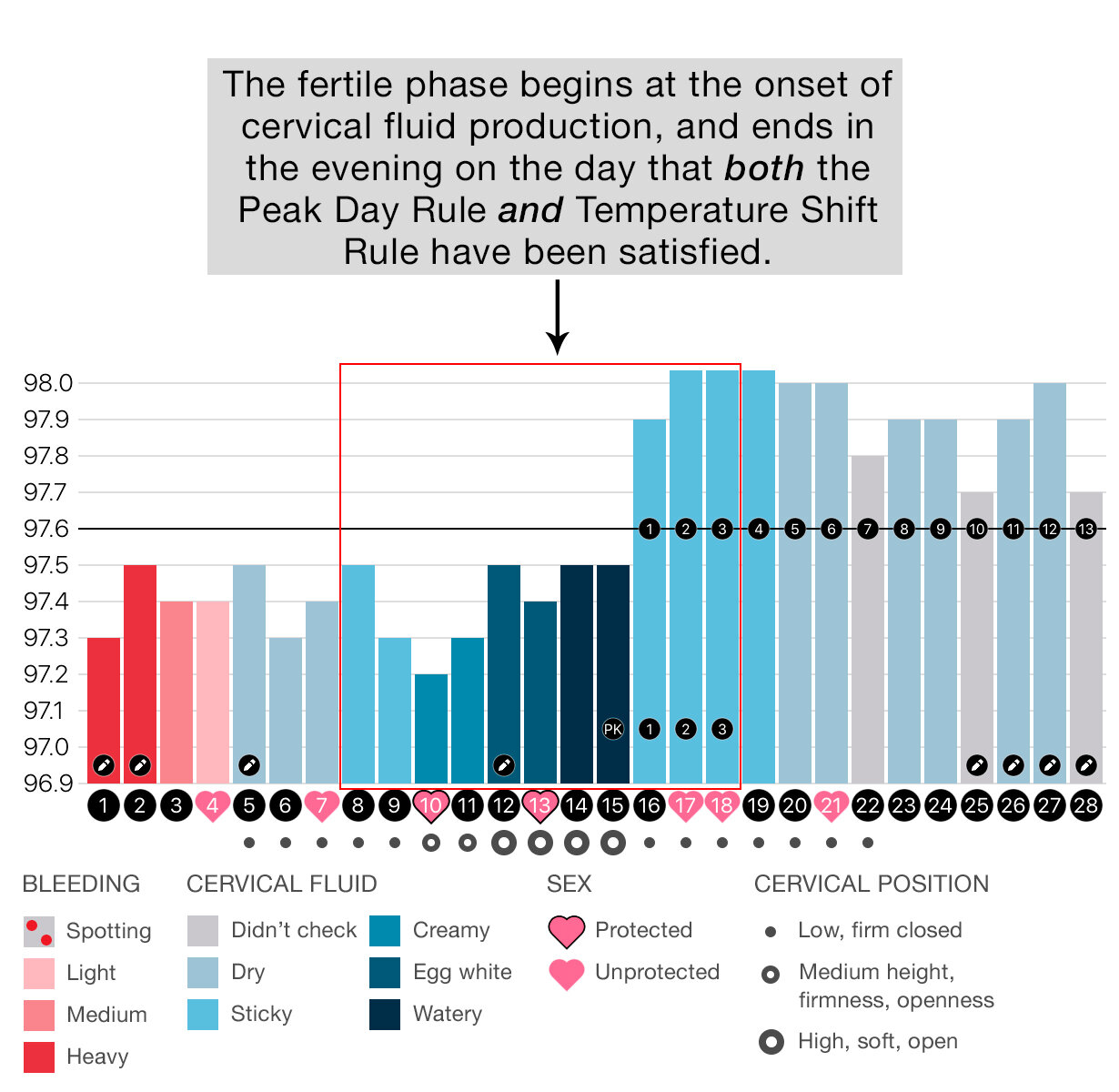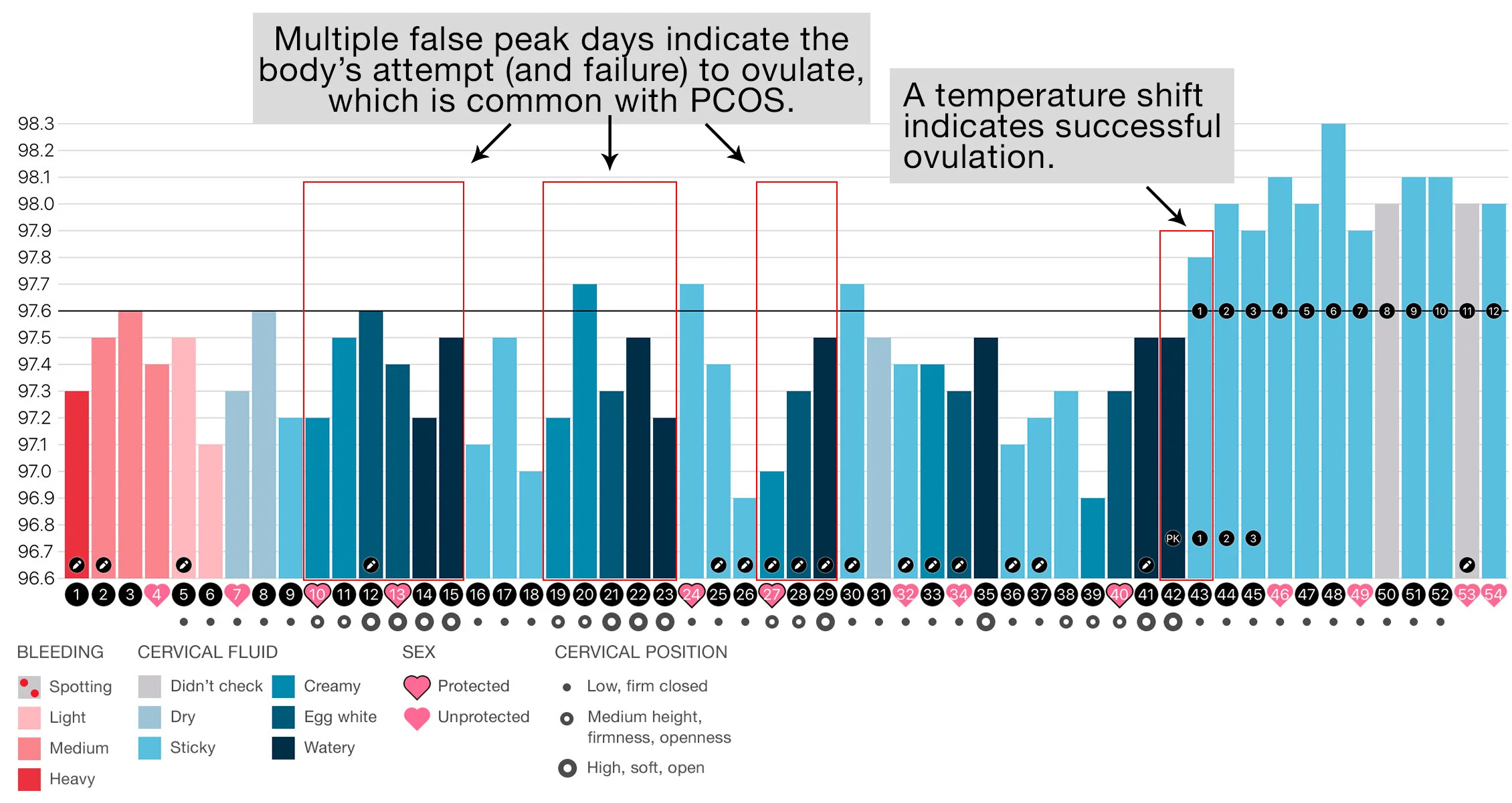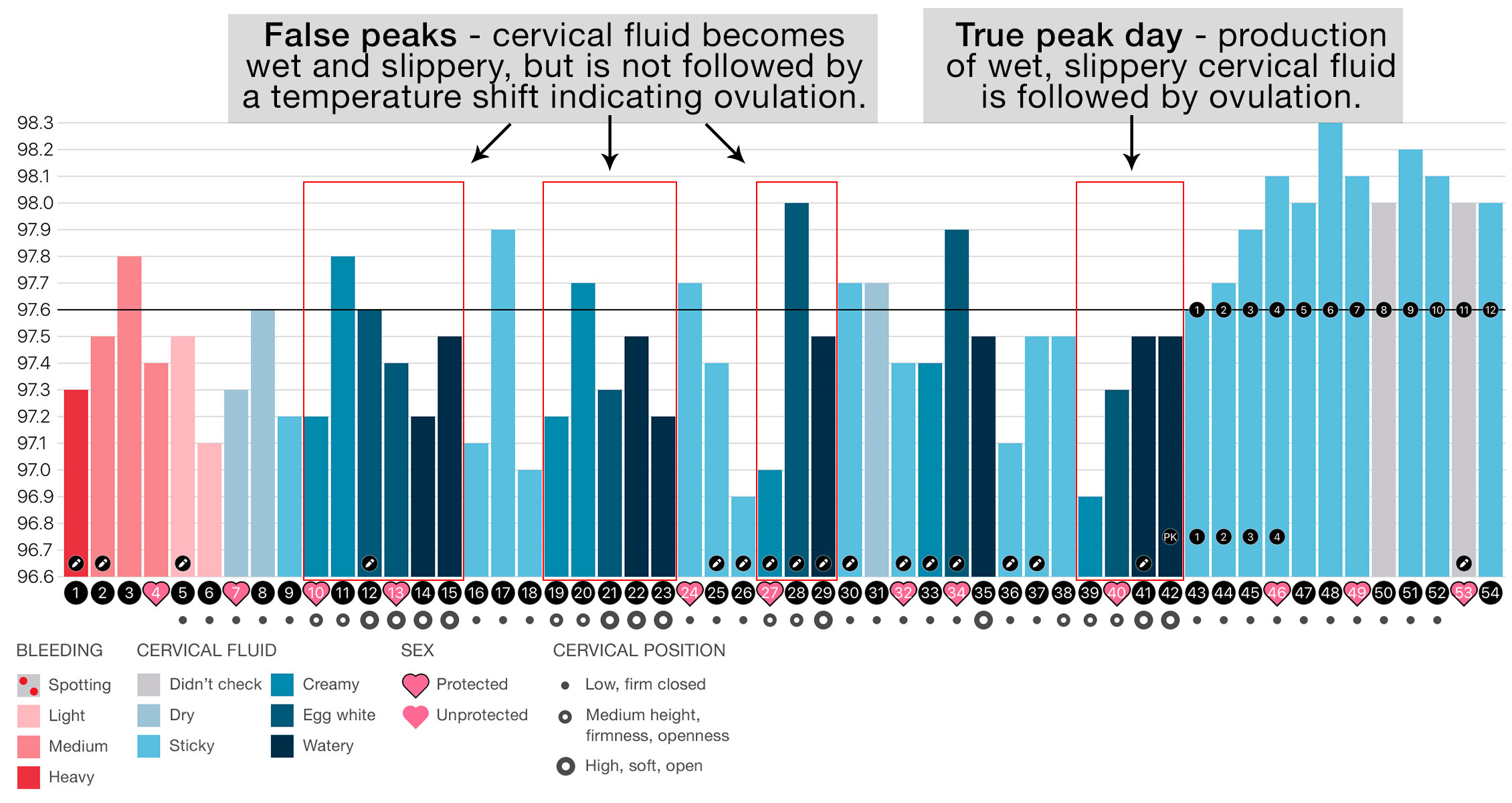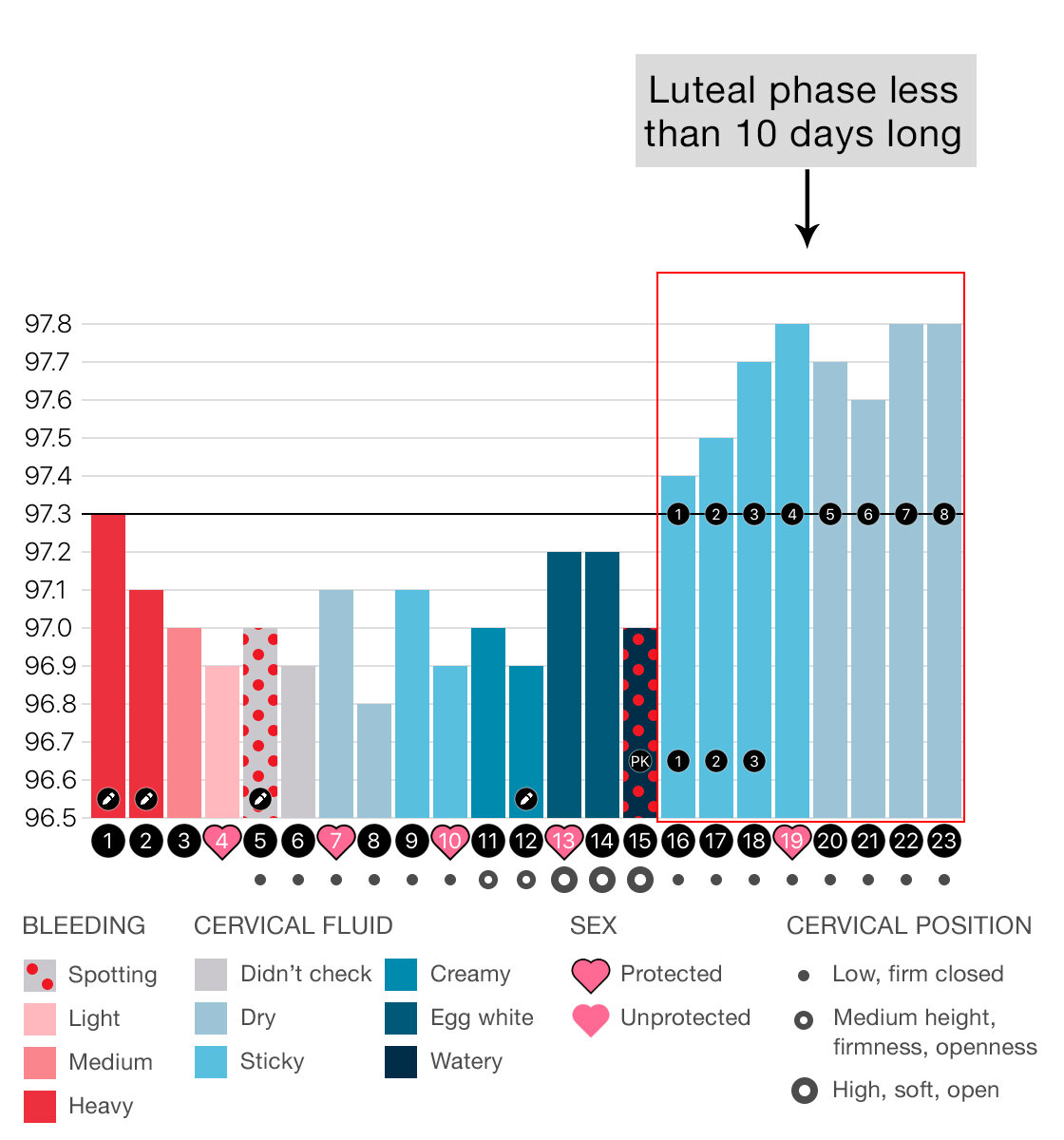Decipher your cycle with these sample Groove charts
Deciphering your menstural cycles isn’t always easy — everyone’s body is a little different. But once you know what to look out for, collecting data about your periods can give you a powerful look into the health of your hormones, your reproductive system, and your body.
Take a gander at the sample charts below (generated by Groove’s period tracking app) to learn how to visualize things like:
your fertile phase
a pregnancy
miscarriage, polycystic ovary syndrome (PCOS)
anovulation
irregular cycles
hormonal imbalance
delayed ovulation
and more!
The fertile phase
The fertile phase in the below cycle begins on Cycle Day 8 when cervical fluid production begins. Since this person experienced a sudden temperature shift on Day 16, the Peak Day Rule is satisfied on the 3rd day after their Peak Day. The Temperature Shift Rule is satisfied on the 3rd consecutive day of a basal body temperature that is above the coverline, since that third temperature is at least 0.3 °F (0.15 °C) above the coverline. The fertile phase ends in the evening on Cycle Day 18, since that is when both the Peak Day Rule and the Temperature Shift Rule are satisfied.
No clue what any of that stuff means? That’s okay! See more sample charts with fertile phase explanations here.
Irregular cycles & PCOS
Individuals with highly irregular cycles or PCOS may experience long periods of time with slippery, fertile cervical fluid production. It’s common to have multiple false peaks, or peak days that are not followed by a temperature shift signaling ovulation.
Highly irregular cycles come in many forms, and may look different than the above sample chart. If you suspect that you have PCOS or cycle irregularity, there are simple lifestyle changes you can make to improve the health of your periods.
Stopping hormonal contraception
Since hormonal contraception halts your body’s natural hormone production, it can take up to a year for your cycles to fully recover after you stop taking it. During the first few post-hormone cycles — while your body is working to kickstart its own production of hormones — it’s common to experience erratic temperatures, unusual cervical fluid patterns, mood disturbances, and delayed ovulation.
Anovulation
Anovulation is defined as a menstrual cycle that lacks ovulation, and it can happen for many reasons. Anovulation can occur in an individual with otherwise healthy menstrual cycles in response to things like extreme stress, heavy exercise, eating disorders, or low body fat percentage. In the sample chart above, you can see that basal body temperature never exhibits a sustained increase, which is a telltale sign of anovulation.
Folks experiencing anovulation may also notice several false peaks, or peak days that are not followed by a rise in basal body temperature. False peaks tell us that the body is attempting to ovulate, but is unsuccessful.
Start reversing period problems in just 30 days…
Our Period Reset program is the most comprehensive period-fixing course available.
Love it, or get your money back!
Pregnancy
The chart below shows a sample pregnancy chart. Notice that, unlike many of the other sample charts on this page, the post-ovulatory rise in basal body temperature is sustained well beyond the 12–16 days that’s typical with a healthy menstrual cycle. This long luteal phase can be attributed to the embryo implanting in the uterine lining.
Once basal body temperature has been high for at least 18 consecutive days after ovulation, pregnancy is a safe assumption.
Postpartum
Postpartum can be one of the most difficult and confusing times to chart fertility signs, but it’s certainly not impossible. When it’s done consistently throughout the day and at night, breastfeeding prevents fertility, ovulation, and menstruation from returning for about six months postpartum.
But once breastfeeding becomes less frequent, the body kick-starts hormone production and will once again resume a natural rhythm. When fertility begins to return during the postpartum time, it’s common to experience unusual cervical fluid patterns, the slow return of slippery, fertile cervical fluid, and unusually short luteal phases after ovulation resumes.
Miscarriage
Unfortunately, 10–25 percent of clinical pregnancies will end in miscarriage, and it can be an incredibly difficult experience. As much as I wish that all wanted pregnancies were carried to term, it’s important to understand the warning signs of miscarriage. Spotting, bleeding, a dropping basal body temperature (BBT), and cramps in the lower back or abdomen are all potential warning signs of a miscarriage. If you notice any of these during your pregnancy (especially during the first trimester), it’s important to talk to your doctor to discuss potential treatment options.
In the sample chart below, basal body temperature begins to drop on Cycle Day 35, light bleeding begins on Day 37, and a miscarriage occurs on Day 38.
False peak cervical fluid days (“false peaks”)
False peaks are defined as peak days that are not followed by a rise in basal body temperature (BBT) that indicate ovulation. They’re common in individuals who have irregular cycles, PCOS, amenorrhea, anovulation, and those who are postpartum.
False peaks are an indication that your body is attempting to ovulate, but is unsuccessful, likely because of improper hormone levels.
Short luteal phase
The luteal phase is the post-ovulatory phase of the menstrual cycle, and it’s dominated by a sex hormone called progesterone. A short luteal phase is 10 or fewer days in length, and it’s common in individuals struggling with low progesterone levels, recurrent miscarriage, and infertility.
Low progesterone
These days, low progesterone occurs at nearly epidemic proportions, and it signals that your hormone health is in disarray.
Here are some telltale signs of an estrogen–progesterone ratio that favors estrogen (meaning progesterone is too low):
consistently low pre-ovulatory temperatures
a slow temperature rise after ovulation
cervical fluid that fails to dry up during the post-ovulatory luteal phase
spotting before your period
severe PMS or PMDD in the days or weeks leading up to your period










